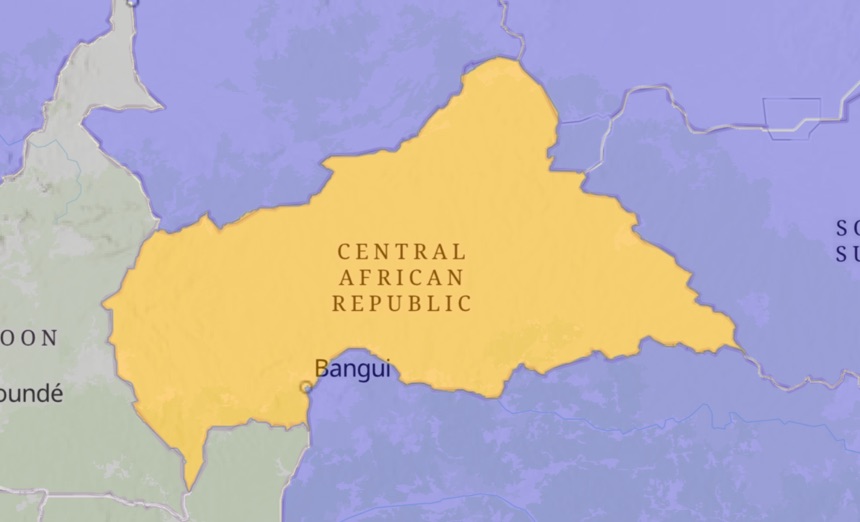The Central African Republic gained independence from France in 1960. While the situation in the country remained relatively stable for years, instability increased following a movement of armed actors across the Chadian border and a failed coup attempt in 1982. Since then, the Central African Republic has experienced several coups d’état, including a mutiny of the armed forces that led to the looting of the state’s arms depot in Bangui in 1996.1 Between 2004 and 2013, the country endured two civil wars that resulted in a proliferation of illegal weapons and ammunition among civilians and various armed groups – undermining security and increasing the risk of accidents and violence.2 A civil conflict in north-eastern Central African Republic escalated into a country-wide crisis and led to a critical breakdown in security and stockpile management systems.3 The country is currently involved in several armed conflicts against non-state actors, such as ex-Séléka and anti-Balaka groups.4
In response to this situation, the UN Mine Action Service (UNMAS) began a weapons and ammunition safety management programme in the country to support the development of the country’s defence and security forces' operational capacities. The national plan on fighting against the proliferation of small arms and light weapons is currently being implemented, also with the support of UNMAS.5 In order to improve security in the Central African Republic, the Swiss Foundation for Mine Action (FSD) has trained personnel on stockpile management issues.6
The Central African Republic has recently demonstrated its commitment to international norms on arms control and to reinforcing its weapons and ammunition management framework. A national weapons and ammunition management baseline assessment was conducted in 2017 in cooperation with the UN Institute for Disarmament Research (UNIDIR), UNMAS and the UN Multidimensional Integrated Stabilization Mission in the Central African Republic (MINUSCA). The new national arms and ammunition legislation was developed with the support of international partners, including MINUSCA and the UN Office on Drugs and Crime (UNODC), and adopted in 2020.7
4 "Central African Republic," Rule of Law in Armed Conflicts Project (RULAC), Geneva Academy of International Humanitarian Law and Human Rights, updated October 12, 2018, www.rulac.org/browse/countries/central-african-republic.
Launch the country dashboard
Further information
Accidental explosions
Since the Small Arms Survey began collecting data in 1979, no accidental explosions at ammunition storage areas have been reported in the Central African Republic.
Source: “Unplanned Explosions at Munitions Sites (UEMS) Database,” Small Arms Survey, updated December 15, 2021, https://smallarmssurvey.org/database/unplanned-explosions-munitions-sites-uems.
Cases of diversion
Several cases of diversion have been reported since 2013 in the Central African Republic.
Table 1. Cases of diversion of arms, ammunition and explosives in the Central African Republic since 2013
Year | Location | Description |
2013 | Throughout the country | The Séléka coalition seized significant amounts of arms and ammunition from government forces and stockpiles, which led to the seizure of power. |
2013–14 | Bangui, Bambari, and throughout the country | Arms and ammunition formerly held in the state’s stocks were widely dissiminated among all of the groups and civilians. |
Source: Conflict Armament Research, Non-state Armed Groups in the Central African Republic (London: Conflict Armament Research, 2015), https://www.conflictarm.com/reports/non-state-armed-groups-in-the-central-african-republic/.
Disposal
Since 2014, 247,116 explosive items, encompassing 194 tons of commercial explosives and more than 2.4 million items of ammunition, have been destroyed with the support of UNMAS. The latter also carried out the destruction of 3,067 non-functional or obsolete weapons collected by MINUSCA under the Disarmament, Demobilization, Reintegration and Resettlement (DDRR) National Programme.
Source: "Central African Republic," UNMAS, September, 2022, https://www.unmas.org/en/programmes/centralafricanrepublic.
Needs
To further enhance safe and secure ammunition management, the following need has been identified for the Central African Republic:
• Capacity development for the destruction of surplus stockpiles, particularly the development and provision of cutting machines.
Source: PoA Report 2022, Central African Republic. https://unoda-poa.s3.amazonaws.com/reports/CAF-French-1251-SUBMITTED.pdf



